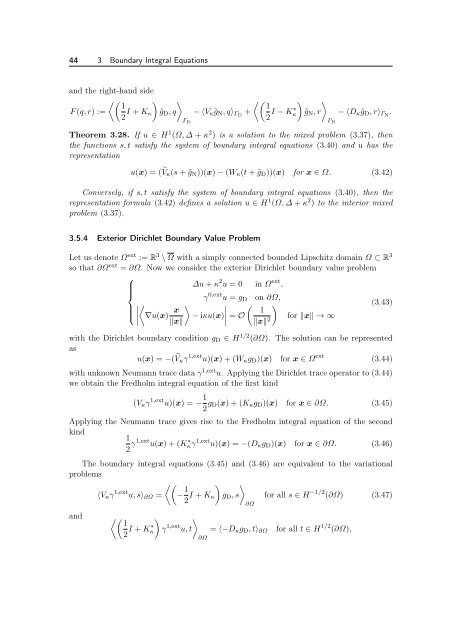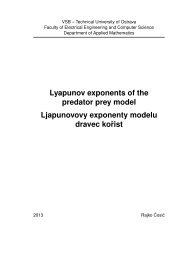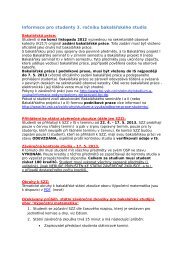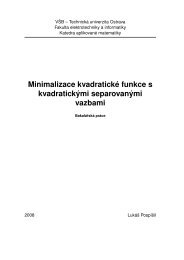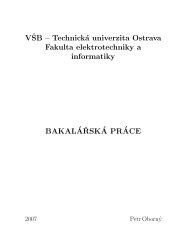The Boundary Element Method for the Helmholtz Equation ... - FEI VÅ B
The Boundary Element Method for the Helmholtz Equation ... - FEI VÅ B
The Boundary Element Method for the Helmholtz Equation ... - FEI VÅ B
You also want an ePaper? Increase the reach of your titles
YUMPU automatically turns print PDFs into web optimized ePapers that Google loves.
44 3 <strong>Boundary</strong> Integral <strong>Equation</strong>sand <strong>the</strong> right-hand side 1F (q, r) :=2 I + K κ ˜g D , q − ⟨V κ˜g N , q⟩ ΓD +Γ D 12κI − K∗ ˜g N , r − ⟨D κ˜g D , r⟩ ΓN .Γ N<strong>The</strong>orem 3.28. If u ∈ H 1 (Ω, ∆ + κ 2 ) is a solution to <strong>the</strong> mixed problem (3.37), <strong>the</strong>n<strong>the</strong> functions s, t satisfy <strong>the</strong> system of boundary integral equations (3.40) and u has <strong>the</strong>representationu(x) = ( V κ (s + ˜g N ))(x) − (W κ (t + ˜g D ))(x) <strong>for</strong> x ∈ Ω. (3.42)Conversely, if s, t satisfy <strong>the</strong> system of boundary integral equations (3.40), <strong>the</strong>n <strong>the</strong>representation <strong>for</strong>mula (3.42) defines a solution u ∈ H 1 (Ω, ∆ + κ 2 ) to <strong>the</strong> interior mixedproblem (3.37).3.5.4 Exterior Dirichlet <strong>Boundary</strong> Value ProblemLet us denote Ω ext := R 3 \ Ω with a simply connected bounded Lipschitz domain Ω ⊂ R 3so that ∂Ω ext = ∂Ω. Now we consider <strong>the</strong> exterior Dirichlet boundary value problem⎧∆u + κ 2 u = 0 in Ω ext ,⎪⎨γ 0,ext u = g D on ∂Ω,⎪⎩∇u(x) x∥x∥ − iκu(x)1 = O ∥x∥ 2<strong>for</strong> ∥x∥ → ∞(3.43)with <strong>the</strong> Dirichlet boundary condition g D ∈ H 1/2 (∂Ω). <strong>The</strong> solution can be representedasu(x) = −( V κ γ 1,ext u)(x) + (W κ g D )(x) <strong>for</strong> x ∈ Ω ext (3.44)with unknown Neumann trace data γ 1,ext u. Applying <strong>the</strong> Dirichlet trace operator to (3.44)we obtain <strong>the</strong> Fredholm integral equation of <strong>the</strong> first kind(V κ γ 1,ext u)(x) = − 1 2 g D(x) + (K κ g D )(x) <strong>for</strong> x ∈ ∂Ω. (3.45)Applying <strong>the</strong> Neumann trace gives rise to <strong>the</strong> Fredholm integral equation of <strong>the</strong> secondkind12 γ1,ext u(x) + (K ∗ κγ 1,ext u)(x) = −(D κ g D )(x) <strong>for</strong> x ∈ ∂Ω. (3.46)<strong>The</strong> boundary integral equations (3.45) and (3.46) are equivalent to <strong>the</strong> variationalproblems⟨V κ γ 1,ext u, s⟩ ∂Ω = − 1 2 I + K κ g D , s <strong>for</strong> all s ∈ H −1/2 (∂Ω) (3.47)∂Ωand 12κI + K∗ γ 1,ext u, t = ⟨−D κ g D , t⟩ ∂Ω <strong>for</strong> all t ∈ H 1/2 (∂Ω),∂Ω


